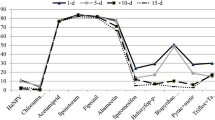Abstract
The work addresses the issue of large scale lac crop mortality caused by parasitoids associated with lac insect, Kerria lacca (Kerr) in some of the lac growing tracts of the country. Laboratory evaluation of four selective insecticides viz., fipronil, indoxacarb, spinosad and ethofenprox was carried out at different concentrations against adults of a primary parasitoid of lac insect, Eupelmus tachardiae (Howard) by exposing the test insects on residual film of insecticides. Insecticides identified and their concentrations selected on the basis of their safety evaluation trials towards lac insect, K. lacca (Kerr). All these insecticides have been recommended and are being used on lac culture for the effective management of insect predators (Lepidopteran and Neuropteran) attacking lac insect. The recommended concentrations for effective management of lac insect predators are fipronil (0.007 %), indoxacarb (0.007 %), spinosad (0.005 %) and ethofenprox (0.02 %). Insecticide fipronil (varied from 0.0012 to 0.01 %), indoxacarb (varied from 0.0017 to 0.02 %) and ethofenprox (varied from 0.01 to 0.04 %) were evaluated at five different concentrations whereas spinosad was evaluated at eight concentrations (varied from 0.00015 to 0.01 %) against E. tachardiae. On the basis of relative residual toxicity, fipronil was found to be most effective treatment followed by spinosad and indoxacarb. Ethofenprox was found to be relatively least effective treatment against the test insect. Fipronil, indoxacarb and spinosad causes cent % mortality of male and female E. tachardiae adults within 24 h of exposure on residual film of insecticides whereas some adults survival was observed with the treatment of ethofenprox during the same exposure period. Cent % mortality of male and female test insect was recorded with the treatment of fipronil (0.007 %) within 1.5 h exposure whereas spinosad (0.005 %) was resulted to 88.5 and 82.4 % male and female mortality of test insect, respectively under same exposure period (1.5 h). However, exposure of test insect on residual film of indoxacarb (0.007 %) and ethofenprox (0.02 %) exhibited no mortality of test insect within 1.5 h exposure. Indoxacarb (0.007 %) caused 65.5 and 53.8 % male and female mortality, respectively whereas ethofenprox (0.02 %) caused mortality of male and female insect to the tune of 12.5 and 15.4 %, respectively within 6 h of exposure. The relative toxicity of insecticides based on time period of knockdown after exposure to residual film of insecticides may be depicted as fipronil > spinosad > indoxacarb > ethofenprox.
Similar content being viewed by others
References
Sharma K, Krishan Ramani R (2001) Parasites effected reduction in fecundity and resin yield of two strains of Indian lac insect, Kerria lacca (Kerr). Ind J Entomol 63(4):456–459
Narayanan ES (1962) Pests of lac in India. A monograph on Lac. Indian Lac Research Institute, Ranchi, pp 90–113
Varshney RK (1976) A check list of insect parasites associated with lac. Oriental Insects 10(1):55–78
Srivastava DC, Chauhan NS, Teotia TPS (1984) Seasonal abundance of insect associated with the Indian lac insect Kerria lacca Kerr. Ind J Ecol 11(1):37–42
Jaiswal AK, Sharma KK, Sushil SN, Bhattacharya A, Mishra YD (1998) Lac associated insect fauna during Storage. Sashpa 5(2):133–136
Jaiswal AK, Bhattacharya A, Kumar KK, Kumar S (2004) Evaluation of ethofenprox (Nukil 10 EC) on lac insect culture for management of Eublemma amabilis Moore—a lepidopteran predator. In: Pandey BN, Natarajan P, Arumugam N, Premjith S (eds) New horizon of animal sciences. Zoological Society of India, Bodh Gaya, pp 47–50
Jaiswal AK, Bhattacharya A, Kumar M, Kumar S (2006) Effect of ethofenprox, cartap hydrochloride and endosulfan on incidence of two major parasitoids, Aprostocetus purpureus Cameron (Hymenoptera: Eulophidae) and Tachardiaephagus tachardiae Howard (Hymenoptera: Encyrtidae) on lac crop. J Entomol Res 30(1):71–73
Jaiswal AK, Bhattacharya A, Kumar S, Patamajhi P (2007) Evaluation of ethofenprox on Chrysopa madestes (Neuroptera: Chrysopidae)—a serious pest of Indian lac insect, Kerria lacca (Kerr). J Entomol Res 31(2):113–114
Bhattacharya A, Jaiswal AK, Kumar S, Kumar M (2005) Evaluation of cartap hydrochloride for management of Eublemma amabilis (Moore)—a serious lepidopteran predator of lac insect. J Appl Zoo Res 16(1):93–94
Singh JP, Jaiswal AK, Md Monobrullah, Bhattacharya A (2009) Response of some selected insecticides on neuropteran predator (Chrysopa lacciperda) of lac insect (Kerria lacca). Ind J Agric Sci 79(9):727–731
Singh JP, Jaiswal AK, Monobrullah MD (2011) Safety evaluation of some newer pesticides against lac insect (Kerria lacca) for managing predators. Ind J of Agric Sci 81(5):465–469
Acknowledgment
The authors are thankful to Dr R Ramani, Director, Indian Institute of Natural Resin and Gums, Ranchi (ICAR) for advice and encouragement during the course of investigation.
Author information
Authors and Affiliations
Corresponding author
Rights and permissions
About this article
Cite this article
Jaiswal, A.K., Singh, J.P. & Patamajhi, P. Residual Toxicity of Certain Newer Pesticides on Eupelmus tachardiae: A Parasitoid of Lac Insect Kerria lacca (Kerr). Natl. Acad. Sci. Lett. 37, 97–101 (2014). https://doi.org/10.1007/s40009-013-0199-y
Received:
Revised:
Accepted:
Published:
Issue Date:
DOI: https://doi.org/10.1007/s40009-013-0199-y



